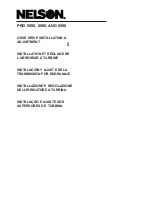
©
National Instruments Corporation
10-1
10
Digital Routing and Clock Generation
The digital ro
u
ting circ
u
itry has the following main f
u
nctions:
•
Manages the flow of data between the b
u
s interface and the
acq
u
isition/generation s
u
b-systems (analog inp
u
t, analog o
u
tp
u
t,
digital I/O, and the co
u
nters). The digital ro
u
ting circ
u
itry
u
ses FIFOs
(if present) in each s
u
b-system to ens
u
re efficient data movement.
•
Ro
u
tes timing and control signals. The acq
u
isition/generation
s
u
b-systems
u
se these signals to manage acq
u
isitions and generations.
These signals can come from the following so
u
rces:
–
Yo
u
r USB-621
x
device
–
User inp
u
t thro
u
gh the PFI terminals
•
Ro
u
tes and generates the main clock signals for the USB-621
x
device.
80 MHz Timebase
The 80 MHz Timebase can be
u
sed as the So
u
rce inp
u
t to the 32-bit
general-p
u
rpose co
u
nter/timers. The 80 MHz Timebase is generated
from the onboard oscillator.
20 MHz Timebase
The 20 MHz Timebase normally generates many of the AI and AO timing
signals. The 20 MHz Timebase also can be
u
sed as the So
u
rce inp
u
t to the
32-bit general-p
u
rpose co
u
nter/timers. The 20 MHz Timebase is generated
by dividing down the 80 MHz Timebase.
100 kHz Timebase
The 100 kHz Timebase can be
u
sed to generate many of the AI and AO
timing signals. The 100 kHz Timebase also can be
u
sed as the So
u
rce inp
u
t
to the 32-bit general-p
u
rpose co
u
nter/timers. The 100 kHz Timebase is
generated by dividing down the 20 MHz Timebase by 200.
















































